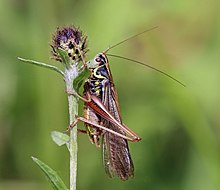| Orthoptera Temporal range: Carboniferous–recent
| |
|---|---|

| |
| Roesel's bush-cricket family Tettigoniidae | |
| Scientific classification | |
| Domain: | Eukaryota |
| Kingdom: | Animalia |
| Phylum: | Arthropoda |
| Class: | Insecta |
| Infraclass: | Neoptera |
| Cohort: | Polyneoptera |
| Order: | Orthoptera Latreille, 1793 |
| Extant suborders and superfamilies | |
|
Suborder Ensifera Suborder Caelifera | |
Orthoptera (from Ancient Greek ὀρθός (orthós) 'straight' and πτερά (pterá) 'wings') is an order of insects that comprises the grasshoppers, locusts, and crickets, including closely related insects, such as the bush crickets or katydids and wētā. The order is subdivided into two suborders: Caelifera – grasshoppers, locusts, and close relatives; and Ensifera – crickets and close relatives.
More than 20,000 species are distributed worldwide.[1] The insects in the order have incomplete metamorphosis, and produce sound (known as a "stridulation") by rubbing their wings against each other or their legs, the wings or legs containing rows of corrugated bumps. The tympanum, or ear, is located in the front tibia in crickets, mole crickets, and bush crickets or katydids, and on the first abdominal segment in the grasshoppers and locusts.[2] These organisms use vibrations to locate other individuals.
Grasshoppers and other orthopterans are able to fold their wings (i.e. they are members of Neoptera).
- ^ "Orthoptera - Grasshoppers, Locusts, Crickets, Katydids". Discover Life. Retrieved 2017-09-06.
- ^ Cite error: The named reference
IIBDwas invoked but never defined (see the help page).